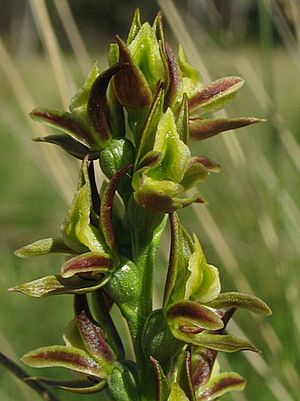Summer leek orchid facts for kids
Quick facts for kids Summer leek orchid |
|
|---|---|
 |
|
| Scientific classification |
The Prasophyllum canaliculatum, often called the channelled leek orchid or summer leek orchid, is a special type of orchid. It only grows in a small area of southern New South Wales, Australia. This orchid has one long, bright green leaf that looks like a tube. It also grows up to twenty-five sweet-smelling flowers that are greenish-red or brownish. You can find it in woodlands, usually at high places around 1,000 m (3,000 ft) above sea level. Sadly, there are only about 200 of these plants left.
Contents
What Does the Summer Leek Orchid Look Like?
The Summer Leek Orchid is a plant that grows from an underground tuber (a swollen part of the stem, like a small potato). It is a perennial plant, meaning it lives for more than two years. It's also deciduous, so some parts might die back in certain seasons.
- Leaf: It has one bright green leaf shaped like a tube. This leaf can be 250–400 mm (9.8–16 in) long and about 3 mm (0.1 in) wide. The bottom part of the leaf is often purplish-red. A part of the leaf, 120–200 mm (5–8 in) long, sticks out beyond the flowering stem.
- Flowers: Between five and twenty-five sweet-smelling flowers grow closely together on a stem that is 50–110 mm (2–4 in) long. The flowers are usually red, greenish-red, or brownish-red and are 7–9 mm (0.3–0.4 in) wide.
- Flower Parts: Like other orchids in its group, the flowers are upside down. This means the labellum (a special lip-like petal) is above the column (the part that holds the pollen) instead of below it.
- The dorsal sepal (the top part of the flower) is narrow and egg-shaped, 7–9 mm (0.3–0.4 in) long and 4–5 mm (0.16–0.20 in) wide. It points downwards.
- The lateral sepals (the side parts) are thin and 7–9 mm (0.3–0.4 in) long, about 2 mm (0.08 in) wide. They stand upright or curve forward.
- The petals are thin, about 7 mm (0.3 in) long and 2 mm (0.08 in) wide.
- The labellum is broadly egg-shaped, about 6 millimetres (0.2 in)* long and 4 mm (0.2 in) wide. It bends upwards near its tip. The edges of the labellum are wide and there is a green or reddish channel (a groove) in its middle.
- Flowering Time: These orchids usually bloom from December to January.
How Did It Get Its Name?
The Summer Leek Orchid was officially described for the first time in 1989 by a botanist named David Jones. He found a sample of the plant in the Wadbilliga National Park. The scientific name canaliculatum comes from a Latin word that means "channelled" or "grooved." This name likely refers to the groove found on the orchid's labellum.
Where Does It Live?
The Summer Leek Orchid is only found in two small groups of plants on the Monaro tableland in New South Wales. It likes to grow among grass clumps in woodland areas. It prefers places that are about 1,000 m (3,000 ft) high.
Why Is It Endangered?
There are only about 200 Summer Leek Orchids left, which makes it a very rare plant. Because of this, the New South Wales Government has listed it as "Critically Endangered." This means it is at a very high risk of disappearing forever.
The main things that threaten these orchids are:
- Feral Animals: Wild pigs and deer can damage the plants and their habitat.
- Weeds: Invasive weeds can grow and take over the space and resources that the orchids need.
- Off-Road Vehicles: Illegal driving of vehicles off designated roads can crush the plants and destroy their environment.
Related pages
- Prasophyllum uvidulum, a species of orchid endemic to Victoria, commonly known as the summer leek orchid.

